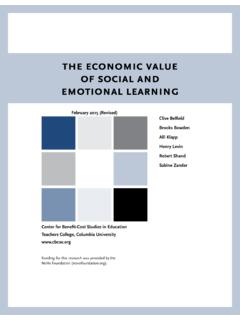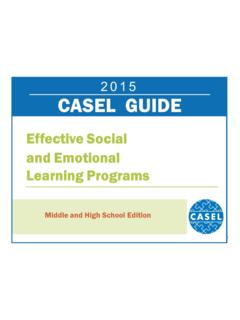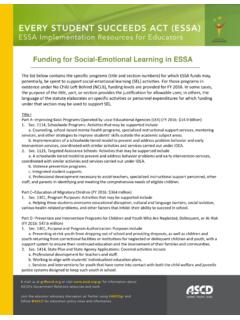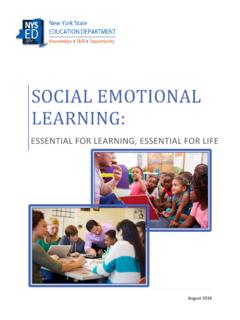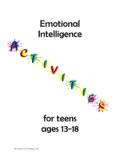Transcription of Incorporating Social and Emotional Learning into …
1 Incorporating Social and Emotional Learning into classroom Instruction and Educator effectiveness : A Toolkit for Tennessee Teachers and Administrators June 2015 The Tennessee Department of Education gratefully acknowledges the collaboration of the Center on Great Teachers (GTL Center) and Leaders and the Appalachia Regional Comprehensive Center (ARCC) in preparing this toolkit. Incorporating Social and Emotional Learning into classroom Instruction and Educator effectiveness 2 Contents Contents .. 2 Toolkit Organization .. 3 Purpose .. 3 Goals .. 3 Audience for the Toolkit .. 4 Toolkit Organization .. 4 Introduction to Social and Emotional Learning (SEL) .. 5 Defining 5 Importance of SEL .. 5 SEL for Tennessee .. 6 Getting Started with SEL .. 6 Where to Find More Information .. 7 Overview of the 10 Teaching Practices.
2 8 Social Teaching Practices .. 10 Teaching Practice 1: Student-Centered Discipline .. 10 Teaching Practice 2: Teacher Language .. 14 Teaching Practice 3: Responsibility and Choice .. 17 Teaching Practice 4: Warmth and Support .. 21 Instructional Teaching Practices .. 24 Teaching Practice 5: Cooperative Learning .. 24 Teaching Practice 6: classroom Discussions .. 27 Teaching Practice 7: Self-assessment and Self-reflection .. 30 Teaching Practice 8: Balanced Instruction .. 33 Teaching Practice 9: Academic Press and Expectations .. 37 Teaching Practice 10: Competence Building .. 40 References .. 44 Incorporating Social and Emotional Learning into classroom Instruction and Educator effectiveness 3 Toolkit Organization Purpose This toolkit is designed to increase administrator and teacher awareness of Social and Emotional Learning (SEL) and help them integrate it into the daily classroom and school experience of students.
3 Specifically, this toolkit is designed to link instructional practices that promote SEL with the Tennessee Educator Accelerator Model (TEAM) teacher evaluation process. Research on SEL, often framed as teaching the whole child or re-humanizing education, demonstrates that when educators focus on Social and Emotional skills of students, they prepare students to participate more fully in instructional activities: by increasing student s capacity to learn (Durlak, Weissberg, Dymnicki, Taylor, & Schellinge, 2011), enhancing student Learning (Elias, 2004), and increasing their motivation to learn and commitment to schooling (Zins, Weissberg, Wang, & Walberg, 2004). Furthermore, one of the goals of TEAM evaluation process is to create a positive classroom experience for all students through defining clear expectations of good practice and providing teachers opportunities to reflect and grow from those experiences.
4 The purpose of this toolkit is to demonstrate that SEL is not another add-on to the already busy agendas of teachers and administrators. Rather, SEL is intertwined with the work teachers and administrators are already doing and is implicitly embedded throughout the TEAM rubric and the professional growth afforded within the TEAM process. By using the TEAM process to integrate SEL, educators can leverage the professional Learning opportunities connected with TEAM to also promote development of student Social and Emotional skills. Goals The goals of the toolkit are: Provide tools, resources, skills, and knowledge to teachers and administrators to help improve student Social and Emotional skills and encourage students to exhibit positive Social behaviors Enhance teachers and administrators knowledge of what teaching practices that focus on SEL look like in the classroom Describe examples of teacher and student behaviors that foster teaching practices to promote SEL Enhance the ability of administrators and teachers to knowledgeably engage in dialogue on SEL within the TEAM process Incorporating Social and Emotional Learning into classroom Instruction and Educator effectiveness 4 Audience for the Toolkit The toolkit is designed to be a starting point for school staff to begin integrating SEL into their teaching practices.
5 Administrators and teachers can use this toolkit to find initial strategies to improve student Social , Emotional , and academic skills. The information, knowledge, and tools can be used by individual teachers to develop professionally, by professional Learning communities focused on SEL, and by administrators as a resource to support the Social and Emotional skills of their teachers and students. Although the toolkit provides information to integrate SEL, those who want to dig deeper into SEL should begin to think about implementing SEL programs and implementing a whole school approach (see For More Information in the next section). Toolkit Organization The toolkit has two primary sections. The first section introduces Social and Emotional Learning , including its definition, research on its importance, relationship to Tennessee initiatives, steps to get started, and organizations that offer more information on SEL.
6 The second section reviews 10 teaching practices that promote SEL, as defined by the Center on Great Teachers and Leaders (GTL Center). This section describes each practice, its alignment to the TEAM rubric indicators, sample teacher activities (demonstrated in videos), teacher practices and student behaviors that demonstrate what the SEL practice looks like in the classroom , and sample discussion prompts that engage teachers and administrators in a two-way dialogue on the SEL connections in the teacher s classroom . Incorporating Social and Emotional Learning into classroom Instruction and Educator effectiveness 5 Introduction to Social and Emotional Learning (SEL) Defining SEL1 According to the Collaborative for Academic, Social , and Emotional Learning (CASEL), Social and Emotional Learning is the process of developing students and adults Social and Emotional competencies the knowledge, skills, attitudes, and behaviors that individuals need to make successful choices.
7 CASEL identifies five Social and Emotional competencies, each of which is composed of multiple skills and abilities (CASEL, 2013): Self-awareness is the ability to recognize one s own emotions, interests, strengths, and limitations. Self-management refers to the ability to regulate one s own emotions and manage daily stressors. Social awareness refers to the capacity to take other s perspective and to appreciate similarities and differences. Relationship skills are when individuals exhibit prosocial behavior and demonstrate positive Social skills in order to develop meaningful relationships. Responsible decision making refers to the capacity to make ethical decisions and develop appropriate solutions to identified problems. Importance of SEL SEL is a universal approach for all students. The goal of SEL is to address the Social and Emotional needs of all students to ensure their success in school and in life.
8 Developing SEL skills improves student capacity to engage in academic Learning and prepares them to meet college and career readiness standards. In order to meet rigorous standards, students need to be able to regulate their emotions when they become frustrated, collaborate with their peers, communicate their ideas, and take the perspective of others (Yoder, 2013). In a major review of 213 studies evaluating SEL programs in schools, Durlak et al. (2011) found that students who participated in SEL programs, compared with students who did not, demonstrated the following attributes: Increased academic achievement Increased Social and Emotional skills Improved attitude toward self and others Improved positive Social behaviors Decreased conduct problems and Emotional distress 1 Although the CASEL framework focuses on defining SEL and describing its components, other frameworks set forth a broad set of skills similar to SEL.
9 Other frameworks include the 21st Century Competencies (National Research Council); Non-Cognitive Factors (Chicago Consortium); and the Strive Network (University of Minnesota). To observe the overlap among these various frameworks, see Hagen, 2013. Incorporating Social and Emotional Learning into classroom Instruction and Educator effectiveness 6 These results were consistent across grade level (elementary, middle, and high school); location (urban, rural, and suburban); and school type (serving a range of ethnically and racially diverse student populations). SEL for Tennessee The convergence of several education initiatives in Tennessee indicates that integrating SEL into TEAM evaluation process is timely: The Tennessee Department of Education (the Department) conducted a crosswalk between 10 SEL teaching practices and TEAM rubric, finding significant alignment.
10 Data gathered from students, parents, and teachers through Tennessee s Safe and Supportive Schools (S3) grant demonstrates a need for greater adaptation and facility with SEL teaching practices. In the Tennessee Educator Acceleration Model project, the Department has state and foundation funding to hire coaches to help administrators accurately assess teacher performance and engage teachers in dialog on improvement with promising early results in improved teaching. Statewide implementation of Response to Instruction and Intervention RTI2, which gives every student the opportunity to meet high expectations, along with strong supports. Getting Started with SEL SEL is considered a universal approach. In other words, SEL is for ALL students and ALL staff because everyone has Social and Emotional needs, concerns, and skills.


